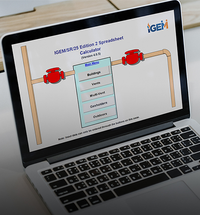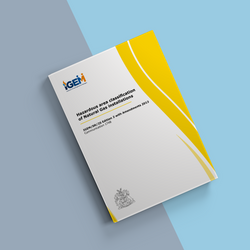
IGEM/SR/25 Edition 2 with amendments 2013 Hydrogen Supplement 1

This Supplement is to be read in parallel with Standard IGEM/SR/25 Edition 2 – with Amendments August 2013. This Supplement outlines where there are differences in the approach for hazardous area classification of installations handling hydrogen, including blends of natural gas/hydrogen (subsequently referred to as NG/H blends with 20% NG/H referring to a 20% (by volume) blend of hydrogen in natural gas) versus the main Standard, which was written for Natural Gas (NG). The clause numbers in this Supplement are as in IGEM/SR/25 Edition 2, but preceded by the letter ‘S’. Users of this Supplement should refer to the clause numbers in the main Standard and any specific, additional requirements and/or qualifications which are given in this Supplement.
This Supplement to IGEM/SR/25 provides a procedure for hazardous area classification around installations handling hydrogen, including a 20% NG/H blend providing a basis for the correct selection and location of fixed electrical equipment in those areas. In addition, the recommended zoning restrictions are relevant with regard to the introduction and use of any temporary mobile electrical equipment or other potential ignition source.
This Supplement is based on work detailed in HSE report FD/21/01 “Development of a Hydrogen Supplement for use with IGEM/SR/25”. The principles in IGEM/SR/25 have been applied successfully in the UK for NG and this Supplement provides information on how to adapt these principles for hydrogen and NG/H blends.
Introduction
S1.1 This Supplement is to be read in parallel with Standard IGEM/SR/25 Edition 2 – with Amendments August 2013. This Supplement outlines where there are differences in the approach for hazardous area classification of installations handling hydrogen, including blends of natural gas/hydrogen (subsequently referred to as NG/H blends with 20% NG/H referring to a 20% (by volume) blend of hydrogen in natural gas) versus the main Standard, which was written for Natural Gas (NG). The clause numbers in this Supplement are as in IGEM/SR/25 Edition 2, but preceded by the letter ‘S’. Users of this Supplement should refer to the clause numbers in the main Standard and any specific, additional requirements and/or qualifications which are given in this Supplement.
Where there is no numbered clause in this Supplement corresponding to a clause in the main Standard, the requirements of the Standard apply in full. If there are no differences in the approach for hydrogen or NG/H blends versus NG then the Supplement refers directly to the content of the main Standard. For such clauses, where references are given to specific Sections, Figures, Tables, Equations and Appendices, both the main Standard and the Supplement need to be consulted to ensure that information is used for the correct fuel. Information given in this Supplement supercedes information in the main Standard for hydrogen and NG/H blends.
For ease of cross-reference between the Supplement and the Standard, any tables or equations contained within the Supplement which have been modified for pure hydrogen or a 20% NG/H blend maintain the same numbering as used in the Standard, but with the inclusion of a preceding ‘S’. Table and equation numbers are suffixed with ‘B’ to reference 20% NG/H blend, ‘H’ to reference pure hydrogen and ‘BH’ to reference both. Where a Section of the Supplement has been updated its numbering is identical to the corresponding Section in the Standard for ease of cross-reference.
S1.2 This Supplement has been drafted by a Panel appointed by the Institution of Gas Engineers and Managers’ (IGEM’s) Gas Transmission and Distribution Committee and is published by the authority of IGEM’s Council.
S1.3 General guidance on the principles, definitions and explanations of terms relating to hazardous area classification has been set out internationally by the International Electrotechnical Commission (IEC) and, in Europe, by the European Committee for Electrotechnical Standardization (CENELEC), followed nationally by bodies such as, in the United Kingdom (UK), the British Standards Institution (BSI). These bodies state (see BS EN 60079-10-1) that, for detailed recommendations regarding the extent of the hazardous areas in specific industries or applications, reference may be made to the codes relating to those industries or applications.
This Supplement to IGEM/SR/25 provides a procedure for hazardous area classification around installations handling hydrogen, including a 20% NG/H blend (see Sub-Section S2.2) providing a basis for the correct selection and location of fixed electrical equipment in those areas. In addition, the recommended zoning restrictions are relevant with regard to the introduction and use of any temporary mobile electrical equipment or other potential ignition source.
S1.4 This Supplement is based on work detailed in HSE report FD/21/01 “Development of a Hydrogen Supplement for use with IGEM/SR/25”. The principles in IGEM/SR/25 have been applied successfully in the UK for NG and this Supplement provides information on how to adapt these principles for hydrogen and NG/H blends.
S1.6 The dispersion of a hydrogen release is determined by the interaction of the momentum and buoyancy forces of the release and the atmosphere within which it is dispersing. For an unimpeded jetted release, for example through a vent, the release momentum dominates and the initial dispersion is dominated by the shear between the release and the atmosphere. However, if the release is at a low velocity or is impeded to such an extent that its momentum is redirected or dissipated, the release buoyancy and atmospheric effects become more important.
There are a number of dimensionless groupings that can be used to estimate which of the factors is likely to be more significant. However, as a rough guide, for all small releases of hydrogen, the dispersion in the atmosphere will dominate, for example, similarly to dispersion of smoke from a cigarette. For larger releases, the stage may be reached (especially in low wind speed conditions) when the release buoyancy is significant and the release will lift-off from the ground and disperse like a plume, for example similar to a smoke plume from a large bonfire.
The methodology used in this Supplement takes these factors into account, with different models (jet dispersion, atmospheric dispersion and plume dispersion) being employed over a range of wind speeds up to 10 m s-1. The values quoted refer to a worst case value found within this range.
S1.7 This Supplement enables the user to provide a hazardous area classification for installations that do and do not meet best practice, with regard to design and/or site location. Consequently, requirements are given for:
- ideal and non-ideal venting arrangements
- enclosures that have:
- more than adequate ventilation
- adequate ventilation
- less than adequate ventilation, which embraces poor ventilation.
Primarily, this Supplement to IGEM/SR/25 enables the user to identify certain hazards associated with hydrogen installations. Legal obligations require operators of such installations to be aware of the hazards and to minimise the risks.
Provision of hazardous area classification and the subsequent compliance is the preferred (and often the only) method of satisfying legal obligations to keep such risks to a minimum (but see Section 3).
S1.9 This Supplement, and the main Standard, make use of the terms “must”, “shall” and “should”, when prescribing particular requirements. Notwithstanding Sub-Section 1.12:
- the term “must” identifies a requirement by law in United Kingdom (UK) at the time of publication
- the term “shall” prescribes a requirement which, it is intended, will be complied with in full and without deviation
- the term “should” prescribes a requirement which, it is intended, will be complied with unless, after prior consideration, deviation is considered to be acceptable.
Such terms may have different meanings when used in legislation, or Health and Safety Executive (HSE) Approved Codes of Practice (ACoPs) or guidance, and reference needs to be made to such statutory legislation or official guidance for information on legal obligations.
S1.13 Requests for interpretation of this Standard in relation to matters within its scope, but not precisely covered by the current text, is to be either:
- addresses to Technical Services, IGEM, IGEM House, 26-28 High Street, Kegworth, Derbyshire, DE74 2DA; or
- e-mailed to [email protected]
These will be submitted to the relevant Committee for consideration and advice, but in the context that the final responsibility is that of the engineer concerned. If any advice is given by or on behalf of IGEM, this does not relieve the responsible engineer of any of his or her obligations.
S1.14 The Supplement was published in November 2022.
Scope
S2.1 This Supplement to IGEM/SR/25 complements BS EN 60079-10-1 by providing detailed requirements for the hazardous area classification of permanent and temporary hydrogen or NG/H blend (as defined in Sub-Section S2.3) installations. A hazardous area is an area in which explosive gas/air mixtures are, or may be expected to be, in quantities such as to require special precautions for the construction, installation and use of electrical apparatus or other sources of ignition.
Note: Releases of heavier-than-air or neutrally-buoyant gases and vapours are covered by EI IP MCSP-P15.
S2.2 This Supplement to IGEM/SR/25 applies to all hydrogen or NG/H blend (as defined in Sub-Section S2.3) installations. However, for any installation downstream of an emergency control valve (ECV), other Standards may more readily be applied, as follows (the user to check whether the Standard has been revised or a corresponding Supplement has been issued to cover hydrogen or NG/H blends):
- for primary and secondary meter installations in industrial and commercial premises, where the equipment has been installed in accordance with IGEM/GM/5, IGEM/GM/6, IGEM/GM/8 or BS 6400 and has been tested to, and complies with IGE/UP/1, IGE/UP/1A, IGEM/UP/1B or IGEM/UP/1C (as appropriate), IGEM/GM/7A and IGEM/GM/7B may be applied rather than this Supplement to IGEM/SR/25 but this Supplement to IGEM/SR/25 has to be applied to installations where any one of the following apply:
- ventilation is of the forced type
- maximum operating pressure (MOP) exceeds 75 bar
- creep relief vents terminate within the installation enclosure
- the installation is at a remote, unmanned, site
- it is considered that leaks may go undetected
- unodourised gas is metered
- a competent person considers there to be unusual site circumstances.
- for industrial and commercial installations downstream of the primary meter installation, or downstream of the ECV if a meter installation is not installed, where the installation has been installed in accordance with IGEM/UP/2, IGEM/UP/3, IGEM/UP/6, IGEM/UP/9, IGEM/UP/10 or IGEM/UP/12 and tested in accordance with IGE/UP/1 or IGE/UP/1A the new Standard, IGEM/UP/16 will apply. However, this Supplement to IGEM/SR/25 may still have to be applied to, for example higher pressures; non-standard designs and hazardous areas created by other energy sources, etc.
In general, this Supplement to IGEM/SR/25 will not be less conservative than these other Standards and, therefore, it may be used for any hydrogen installation. If the Standards listed above are not relevant to, or have not yet been updated for, hydrogen and/or NG/H blends then this Supplement is to be applied.
Note 1: It is recognised that there are other techniques available to enable the management of risk, for example dilution ventilation.
Note 2: IGEM/GM/7A contains specific procedures relating to electrical connections to gas meters.
Note 3: It would not be normal to apply IGEM/SR/25 to a single domestic gas installation.
S2.3 This Supplement applies to:
• pure liquid-free hydrogen with gas quality specification in accordance with IGEM/H/1;
• liquid-free 20% hydrogen / 80% natural gas by volume (referred to in this Supplement as 20% NG/H blend) with gas quality specification for hydrogen in accordance with IGEM/H/1 and gas quality specification for NG in accordance with IGEM/SR/25.
The ambient and gas storage temperature ranges used for hydrogen and NG/H blends are as given in the current version of IGEM/SR/25, Section 2.3 for NG. Zoning distances for fixtures and fittings are given up to an operating pressure of 100 bar for NG/H blends and up to 200 bar for pure hydrogen, recognising the potential for higher pressure hydrogen storage systems.
S2.4 A zone of negligible extent is only applicable in this Supplement to:
- pure hydrogen installations of MOP not exceeding 2 bar
- 20% NG/H blend installations of MOP not exceeding 10 bar.
S2.5 This Supplement applies to any potential release of hydrogen except those that may be caused by catastrophic failure such as the rupture of a process vessel or pipeline, component failure and similar rare events that are not predictable.
S2.6 Certain aspects of the design of new plant and equipment can affect significantly the nature and severity of the eventual hazardous area classification.
This Supplement to IGEM/SR/25 is not intended to provide design details for equipment. However, compliance with the general principles of design set out in Section 4 and Appendix 4 will help minimize the severity of the hazardous area classification.
Gases are classified according to the ignitability of the gas/ air mixture as defined in BS EN 60079-20-1 (i.e. IIA, IIB, IIC). Equipment protection ratings are suitable for the NG/H blend and/ or pure hydrogen installation.
S2.7 For a process map, which may assist the user in understanding the complexities of undertaking hazardous area classification. See Appendix 11 of the main Standard.
S2.8 All pressures quoted are gauge pressures unless otherwise stated.
S2.9 Italicised text is informative and does not represent part of a formal Supplement.
S2.10 Appendices are informative and do not represent part of a formal Supplement unless specifically referenced in the main sections via the prescriptive terms “must”, “shall” or “should”.


